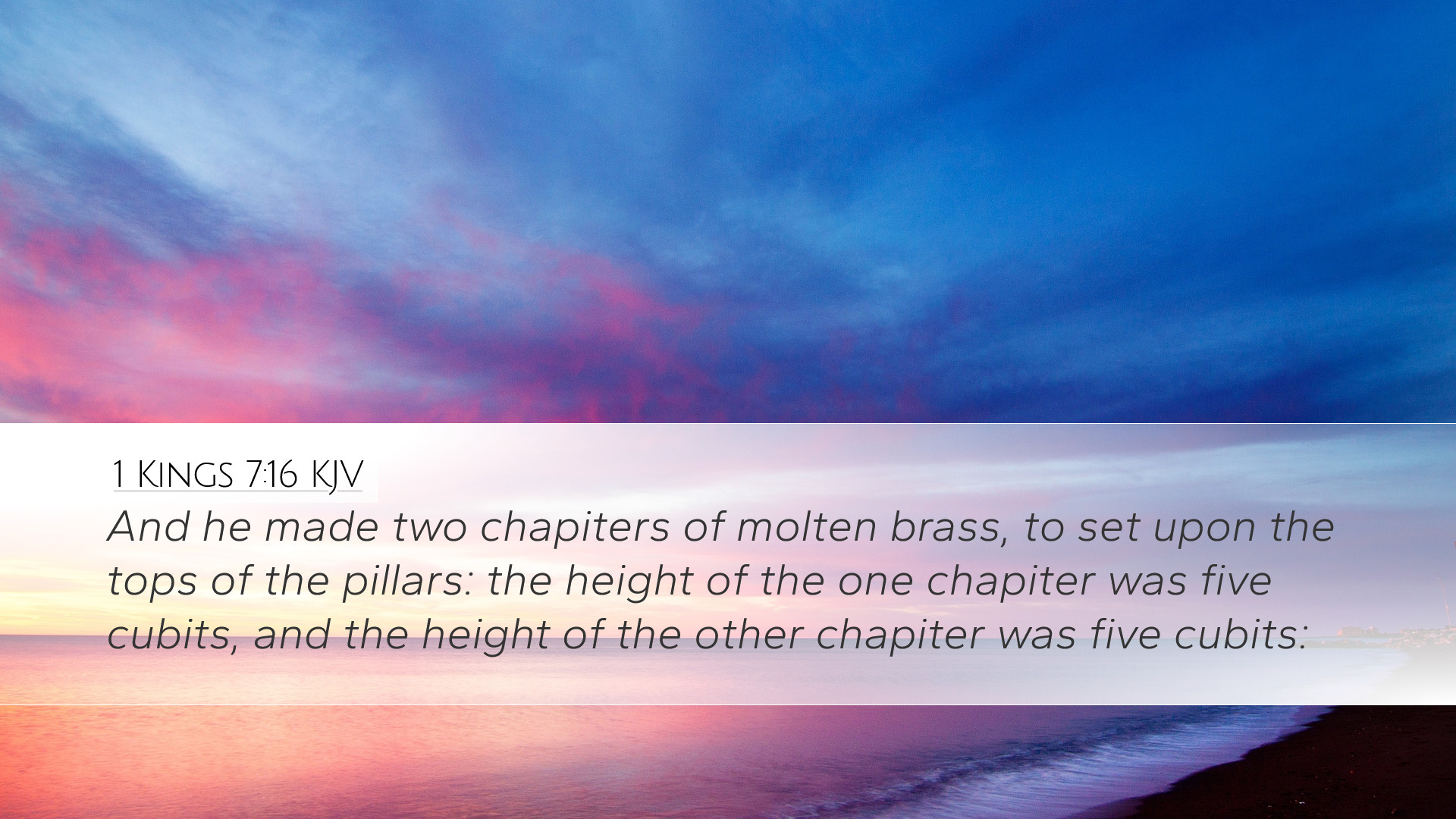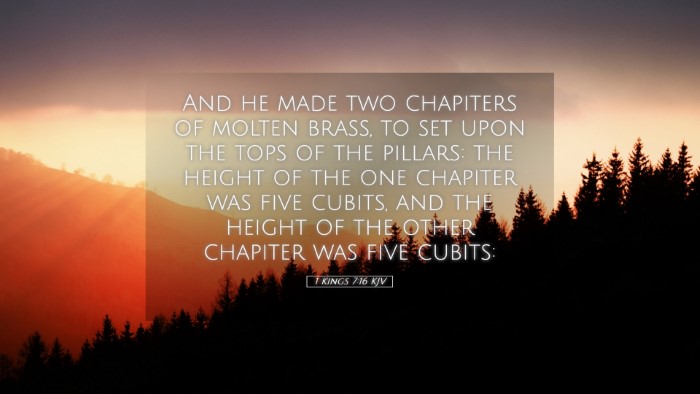Commentary on 1 Kings 7:16
Verse Reference: 1 Kings 7:16 - “And he made two pillars of brass, eighteen cubits high apiece: and a line of twelve cubits did compass either of them about.”
Introduction
This verse describes the construction of the two pillars known as Jachin and Boaz that stood before the Temple built by Solomon. These pillars not only served structural purposes but also carried significant symbolic meaning for the Israelites. The construction details provided are monumental in understanding the grandeur of Solomon's temple and the emphasis on craftsmanship in ancient Israel. The insights derived from the commentaries of esteemed scholars unpack the theological implications and the rich symbolism embedded in this verse.
Insights from Public Domain Commentaries
Matthew Henry’s Commentary
Matthew Henry emphasizes that the pillars symbolize stability and strength. He notes that Solomon's work is characterized by grandeur and emphasizes the importance of the materials used. The use of brass is noteworthy, as it implies durability and brightness, indicating that the temple should inspire awe and reverence.
- Henry points out that the height of the pillars (eighteen cubits) represents strength, towering above ordinary structures and signifying the greatness of God.
- He also highlights that the twelve-cubit circumference around the pillars illustrates perfection and completeness in God's creation.
Albert Barnes’ Notes
Albert Barnes elaborates on the construction process and the architectural significance of the pillars. He provides a detailed analysis of their dimensions and the craftsmanship involved.
- Barnes notes that the pillars served not only as decorative elements but also bore practical purposes within the temple’s sacred space, marking the entrance and setting apart the holy sanctuary.
- He explains that the names Jachin and Boaz (meaning "He establishes" and "In Him is strength") signify God’s assurance of stability and support for His people.
Adam Clarke's Commentary
Adam Clarke provides a thorough cultural context which enhances the understanding of the significance of the pillars in the ancient world. He discusses the symbolism tied to pillars in various civilizations, drawing connections to the Israelites.
- Clarke remarks that pillars commonly symbolize strength and endurance, reflecting God’s everlasting nature.
- He also emphasizes their role in the worship space as markers of God's presence, inviting believers to approach with both reverence and faith.
- Additionally, Clarke elaborates on the materials used in the pillars, underlining that the use of brass (a symbol of judgment but also of beauty) illustrates the duality of God's nature.
Theological Implications
The construction of the pillars serves as a focal point for understanding the nature of worship in ancient Israel. The meticulous design reflects the awe that God's presence evokes. Through the symbolism of stability and divine strength, congregants are reminded of their reliance on God. The dual identities of the pillars—with their intricate details—vividly portray the engagement of the community in the worship of a powerful and present God.
Symbolism in Worship
Worship conducted in a physically grand space mirrors the spiritual stature of the God being worshiped. The towering pillars, as noted by our commentators, serve to remind worshippers of both the majesty of God and their own position before Him.
Cultural Reflections
Furthermore, the cultural significance cannot be overlooked. In historical contexts, pillars were not merely aesthetic; they often carried religious or political symbolism. The pillars signify the divine endorsement of King Solomon and the Israelite nation, establishing their identity as God’s chosen people.
Conclusion
1 Kings 7:16 serves more than just a structural purpose; it encapsulates theological themes that resonate across time. The insights from commentaries by Matthew Henry, Albert Barnes, and Adam Clarke present a multifaceted interpretation that highlights both the practical and spiritual dimensions of the pillars erected in the temple. For pastors, students, and theologians, this verse reinforces the profound relationship between God, worship, and the identity of His people.


